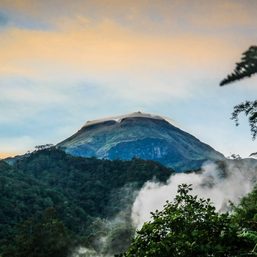SUMMARY
This is AI generated summarization, which may have errors. For context, always refer to the full article.
![[OPINION] Small is beautiful: Ipil-ipil for a climate-challenged Philippines](https://www.rappler.com/tachyon/2022/10/Screen-Shot-2022-10-05-at-5.06.47-PM.png)
The following is the 42nd in a series of excerpts from Kelvin Rodolfo’s ongoing book project “Tilting at the Monster of Morong: Forays Against the Bataan Nuclear Power Plant and Global Nuclear Energy.“
So much of my writing has criticized the nuclear effort of the first President Marcos, that it feels good to say something nice about another of his energy programs. It failed, but deserves a second effort, modified to serve a nation and people struggling with climate change.
Steep oil prices from the 1973 OPEC embargo are why Marcos went nuclear and started building BNPP in 1976. But in March 1979 the Three Mile Island accident in Pennsylvania stopped construction. Marcos’ Commission on Nuclear Reactor Plants then concluded that BNPP wasn’t safe, so he proclaimed it dead “unless…Westinghouse introduces fundamental changes in design and adapts additional, adequate, and acceptable safeguards to ensure its safety and protect the health of the public.” But construction eventually resumed anyway.
The 1979 Three Mile Island accident also seems to have triggered Marcos’ Dendro Thermal Program that year…as an alternative to BNPP? It was designed to generate 676 megawatts, slightly more than BNPP’s 621. By raising and burning fast-growing ipil-ipil trees, the program was intended to replace the 30% of the imported oil the country was burning to generate electricity. Dendro- means “tree” and thermal pertains to “heat.”
Ipil-ipil
“Lead trees” in English, the scientific name of the species is Leucaena leucocephala, Greek for “whitehead,” referring to its large spherical flower clusters. It is a legume, as its pods proclaim. It shares the Mimosoideae family with mimosa and acacia.
Ipil-ipil was the “miracle tree” of the 1970s and 1980s because of its many uses. Like so many other good things from southern Mexico, the Spanish brought ipil-ipil to us on 16th century Manila galleons, to use its leaves and pods as fodder for their horses and cattle. From the Philippines it spread rapidly throughout Southeast Asia – so rapidly it can be invasive, crowding out native species if unmanaged. But it can be used to deliberately choke out undesirable plants.
Being a legume, ipil-ipil adds nitrogen to the soil. It serves as “green-mulch” nitrogen fertilizer for rice. And growing ipil-ipil can absorb hazardous contaminants from soil, air, and water.
For such a fast grower, ipil-ipil is surprisingly hard! American makers of musical instruments and fine furniture call it “merbau” and prize its dark brown color; dense, straight grain; and stability.
It is most used as firewood and charcoal and feed for horses, cattle, goats, sheep, chickens, prawns, and fish in ponds. People eat the young pods, leaves, and seeds. But, like cattle, if you eat too much you may lose your hair.
Some enzymes in both ipil-ipil and bacteria in cattle intestines make mimosine, a substance that slows weight-gain and causes hair loss, goiter, and throat ulcers. But Hawaiian Synergistes jonesii bacteria neutralize mimosine, and can inoculate animals from it elsewhere. Mimosine can also be reduced in feed by heating or soaking in water, or storing moist above 70 °C.
Mimosine isn’t all bad! It has long been a folk remedy for worms in children and chickens. Dr. Godofredo U. Stuart Jr.’s astonishing compilation of medicinal uses for mimosine include anti-cancer, anti-inflammation, anti-fibrosis, anti-influenza, and anti-virus.
What went wrong?
Ipil-ipil’s fast growth lent itself well to the Dendro Thermal Program. But, being a pioneer country trying to make megawatts of electricity from biomass, the Philippines had no earlier experience to learn from, and of course it made mistakes.
The program had good intentions, to electrify rural areas and provide livelihood there. But Marcos always was impatient and went too big; that and the same lack of attention to science at BNPP led to its collapse.
The program was supposed to generate 3 megawatts each at 217 thermal plants. Each would burn ipil-ipil grown on a 1,200-hectare plantation of public land, farmed in 100-hectare sectors by associations of families. The electricity would be fed into the national grid – a mistake, because that would guarantee line losses.
Serious problems from the start: farmers were not well-trained; centralized decisions were not transmitted properly to local operators, who should have been independently empowered in the first place. There was no system for farmers to share experience. Yearly yields were only a quarter as much as the expected 75-100 cubic meters of wood per hectare.
People call programs that start burning hot but die down quickly ningas-kogon, “tall-grass fires.” Financial support ended after only two years. Political instability, increased by the 1983 Aquino assassination was unhelpful. By 1984, there was only enough ipil-ipil for 17 thermal plants. In 1985, only nine were operating, and only two had enough fuel. Then oil prices fell to only $10 per barrel in 1986, reducing the urgency that had driven the project.
But the worst disaster was brought about by psyllids, tiny “Jumping Plant Lice”.
Psyllids
Its scientific name is Heteropsylla cubana because they were discovered in Cuba in 1914, although psyllids may have arisen elsewhere in central America. Importantly, Heteropsylla eat only ipil-ipil! This means that they first evolved into a stable community with organisms that moderated their numbers, most likely by eating them. Otherwise, unchecked, they would have devoured their only food source, and themselves, out of existence.
The Pacific trade winds had blown the Manila Galleons carrying ipil-ipil saplings and seeds to the Philippines. Centuries later in 1984, high trade winds wafted psyllids – but not their predators – from Central America to Hawaii. From there, the winds carried them on to the Philippines and most of Southeast Asia, devastating ipil-ipil everywhere.
Adults psyllids stick their eggs to new ipil-ipil branches with threads. In days, the eggs hatch into juveniles that undergo several nymph stages as they graze, tethered to the plants, sucking out their juices for two to three weeks. Finally, adulthood and the ability to jump into the air that gave them their name.
The psyllid plague started waning as local predators discovered it, and as researchers in Cebu, Leyte and the University of the Philippines at Los Baños discovered remedies. But the dendro thermal experience was so bad for the farmers that they abandoned the project.
Reviving Philippine ipil-ipil in a changing climate
Plantations are not simply wood factories! To be healthy and self-sustaining like natural forests, they must be complex, balanced communities of plants, animals, and fungae, as the psyllid disaster taught. “Monocultures,” large, single-crop plantations, are especially vulnerable to adversity.
As our coastal plains drown, the growing population must crowd into higher areas, closer to deforested slopes and landslides. Ipil-ipil’s deep roots, fast growth, and tolerance for poor soils are ideally suited for stabilizing steep, denuded slopes.
Let’s plant ipil-ipil locally on bare slopes, in 100-hectares plots! If communities coordinate cattle-raising, rice and vegetable farming, fishponds, charcoal- and furniture-making, and herbalists, many local eyes will look out for psyllids and other problems and seek solutions. This would generate much employment and distributed wealth.
Oh. Electricity? Barangay-sized, barangay-maintained dendrothemal systems?
A well-funded and staffed Ipil-Ipil Center at UPLB could coordinate, not just for the Philippines, but for Southeast Asia. Did you know that UPLB, founded in 1909 by the Commonwealth, served as the model for all the younger land-grant state agricultural colleges in America? UPLB remains world-class today. – Rappler.com
Born in Manila and educated at UP Diliman and the University of Southern California, Dr. Kelvin Rodolfo taught geology and environmental science at the University of Illinois at Chicago since 1966. He specialized in Philippine natural hazards since the 1980s.
Keep posted on Rappler for the next installment of Rodolfo’s series.
Previous pieces from Tilting at the Monster of Morong:
- [OPINION] Tilting at the Monster of Morong
- [OPINION] Mount Natib and her sisters
- [OPINION] Sear, kill, obliterate: On pyroclastic flows and surges
- [OPINION] Beneath the waters of Subic Bay an old pyroclastic-flow deposit, and many faults
- [OPINION] Propaganda about faulting, earthquakes, and the Bataan Nuclear Power Plant
- [OPINION] Discovering the Lubao Fault
- [OPINION] The Lubao Fault at BNPP, and the volcanic threats there
- [OPINION] How Natib volcano and her 2 sisters came to be
- [OPINION] More BNPP threats: A Manila Trench megathrust earthquake and its tsunamis
- [OPINION] Shoddy, shoddy, shoddy: How they built the Bataan Nuclear Power Plant
- [OPINION] Where, oh where, would BNPP’s fuel come from?
- [OPINION] ‘Megatons to Megawatts’: Prices and true costs of nuclear energy
- [OPINION] Uranium enrichment for energy leads to enrichment for weapons
- [OPINION] Introducing the nuclear fuel cycle
- [OPINION] On uranium mining and milling
- [OPINION] Enriching and fabricating BNPP’s uranium fuel
- [OPINION] Decommissioning BNPP, and storing the nuclear dragon’s radioactive manure
- [OPINION] So how much greenhouse gas does nuclear power really generate?
- [OPINION] Getting up close and personal with the atom, and its nucleus that powers NPPs
- [OPINION] The nucleus and isotopes: Why BNPP needs Uranium 235, Not Uranium 238
- [OPINION] What you should know about radioactivity
- [OPINION] Uranium mine waste and the weird idea of half-life
- [OPINION] How nuclear power plants work: Hot monster piss from Morong
- [OPINION] What if there was a spent-fuel pool accident at the Bataan Nuclear Power Plant?
- [OPINION] Nuclear weaponry, its radiation, and human health
- [OPINION] What Chernobyl could have taught us, but hasn’t been allowed to
- [OPINION] Activating BNPP would give cancer to workers and adults living nearby
- [OPINION] Activate BNPP? You could increase childhood cancers in Bataan and beyond
- [OPINION] The Hanford Site: Where nuclear pollution began and still reigns
- [OPINION] Enewetak, Paradise Lost: Enewetak and its people
- [OPINION] The Cold War’s nuclear weapons tests, and the damage and waste they left behind
- [OPINION] Nuclear weapons tests and the dangers of the Runit Dome
- [OPINION] The fates of Enewetak Atoll and its people after the nuclear tests
- [OPINION] The long-term future of nuclear wastes
- [OPINION] Paying respect to our own star
- [OPINION] The paradox of the faint young sun, the origin of life, and the modern cell
- [OPINION] Sunlight and earth-glow
- How the ‘greenhouse effect’ works
- [OPINION] Global warming, climate change, and implications for the Philippines
- [OPINION] Alternative energy for a climate-challenged Philippines
Add a comment
How does this make you feel?





There are no comments yet. Add your comment to start the conversation.